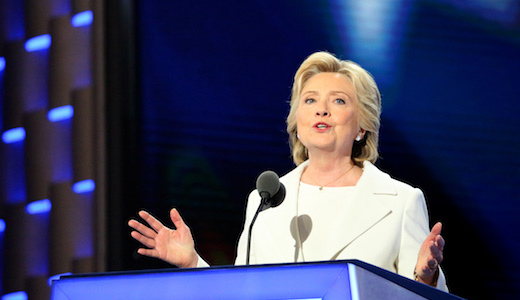
Sexism is alive and well in America. It may be the reason Donald Trump is surging in the polls. But few seem to want to admit that. For example, in an interview with NPR, political pundit David Axelrod said the intense media scrutiny Hillary Clinton has received, and which Trump “seems to skip around,” is not because she is a woman, but because she has been in politics for so long.
Axelrod, however, is not alone in denying unequal media treatment because of gender. Sexism has become normalized and the media have much to do with its normalization. With a cookie cutter approach to so-called fair and equal treatment, the media are engaged in “he said, she said” coverage.
“He said, she said” journalism
One of the most egregious examples of this phenomenon was the way the media covered (or failed to cover) Clinton’s important speech about the fringe white supremacist right wing taking over the Republican Party. The speech was a warning to the nation about the unprecedented danger the Trump campaign poses. Yet it was dismissed “she said/he said”-style when Trump retorted, in his usual Don Rickles one-liner style, “Hillary Clinton is a bigot!” And headlines like, “Clinton, Trump swap insults,” equated the two.
Clinton’s fact-based, logical argument about having racist and anti-Semitic pathological liars in charge of a major political party, and possibly taking over the presidency, was reduced to rubble by the media’s equivalency reporting.
“He said, she said” journalism describes how the media often cover politics, elections and candidates. NYU journalism professor Jay Rosen described the “formula.” “There’s a public dispute. The dispute makes news. No real attempt is made to assess clashing truth claims in the story… The symmetry of two sides making opposite claims puts the reporter in the middle between polarized extremes.” It is like a boxing announcer: “In this corner we have candidate A and in this corner we have candidate B.” Whatever happens in the ring is reported within the rules of boxing.
It has become cliché to say that in this election the rules have been tossed out by Trump and his blitzkrieg of lies, hate, racism, Islamophobia, immigrant bashing, misogyny, profiteering and pathological vanity. But what has not been talked much about is how the rules have changed because now there is a woman in the ring.
Sexist assumptions
U.S. News and World Report writer John Stoehr said that the media should stop making “false equivalencies” between Trump and Clinton. Stoehr says the media’s obsession “for equivalence where there is virtually none” is “endemic,” and criticizes the “tit-for-tat, volley between equals” reporting.
Yet in a “he said, she said” world, where the “she” is actually a “she,” sexist assumptions stack up against her. Trump says the most outrageous things and is celebrated for “speaking his mind.” Clinton “speaks her mind” using the word “deplorable” and she gets excoriated.
I associate the phrase “he said, she said” with a rape trial, where a man says it wasn’t rape and a woman says it was. Getting a rape conviction based on victim and suspect testimony is next to impossible (unless racism is at work). Judges and juries are less likely to believe women than men. Women were considered unreliable, assumed to have “asked for it” or even thought to have enjoyed the assault. This attitude that a woman is less trustworthy than a man goes back for centuries and continues today with consequences that go beyond the criminal justice system.
In his recent article, “When a crackpot runs for president ,” New York Times columnist Nicholas Kristof makes some noteworthy observations about this state of affairs. Kristof writes, “A CNN/ORC poll this month found that by a margin of 15 percentage points, voters thought Donald Trump was ‘more honest and trustworthy’ than Hillary Clinton. Let’s be frank: This public perception is completely at odds with all evidence.”
Pointing to the widely quoted PolitiFact website, Kristof writes that a whopping 53 percent of Trump’s statements were rated “false” or “pants on fire” compared to 13 percent of Clinton’s.
Kristof’s point is important: Despite mounds of evidence to the contrary, Clinton is seen as less trustworthy and honest than Trump. Hillary Clinton may have written her autobiography, but she is not in control of her story. There are larger forces at work shaping how people see her and what they believe about her.
Sexism is a toxic smog that we breathe in every day
I would suggest that, like racism, which scholar and clinical psychologist Beverly Daniel Tatum described as “smog in the air,” sexism too is a toxic smog that we breathe in every day, and as Tatum wrote, everyone “needs to take responsibility…for cleaning it up.”
The first step to cleaning it up is to know it exists.
On one level, sexism is obvious. “Rape culture,” pay inequity, the GOP’s “war on women,” sexual harassment at the workplace (thank you Gretchen Carlson and the other women at Fox for the felling of Roger Ailes), domestic violence, attacks on Planned Parenthood and women’s health access to abortion and birth control, “mansplaining” are well-known examples of gender inequality.
But when it comes to the first woman nominated by a major political party for the presidency, some find it harder to recognize. Some, particularly on the left, argue her hawkishness in foreign affairs, her neoliberal tendencies and her husband’s checkered record as president (NAFTA, Crime bill, etc.) immunize Clinton from sexist attitudes found on the left and among progressives. The bruising battle during the primary between Clinton and democratic socialist Bernie Sanders helped to fuel this illusion.
Even in the People’s World, one opinion article dismissed outright sexism as a factor in one of Robert Reich’s critiques of Clinton, and even included an embarrassing argument that could be interpreted as an Adam’s Rib narrative – that Hillary was created out of Bill’s rib – by basically arguing she was her husband’s co-president.
For progressives to deny, downplay, omit or even unwittingly perpetuate the sexist lens through which we see Clinton, is to cede the election to Trump.
Sexism, a combination of economic, political, and social structures, keeps women of all classes, races, and ethnicities in an unequal state of being compared to men, and the accompanying ideology and culture that justify such inequality. Sexism, along with patriarchy, misogyny, and gender norms, has been a part of human society since the first division of labor, accumulation of wealth, organized social and political hierarchy. It has its own expressions, and dynamically interacts with class and race-based discrimination.
Sexist assumptions pervade every nook and cranny of society and get reproduced through cultural, economic, political, social, educational and media outlets. There are still many career fields and workplaces that are male-dominated, including science, politics and the media. According to one study, women who succeed in male-dominated careers are often viewed negatively.
But even in the recent Atlantic article, “The death of ‘he said, she said’ journalism ,” about The New York Times ending its usual practice of “symmetrical” reporting between Trump and Clinton, misses the fact that for the first time in a U.S. presidential election, the two candidates are indeed, a he and a she. Therefore the coverage that supposedly equates the two sides is more “asymmetrical” because of the unacknowledged sexist bias.
In addition, “he said/she said” journalism in this election has helped to normalize sexism by overlooking it like it is a cost of doing business. The misogyny that surrounded the Republican National Convention and Trump’s subsequent suggestions of violence against Clinton are reported as just another outrageous thing said by the candidate instead of being put into a larger anti-woman context. Here I am glad to say People’s World did an excellent job in exposing the misogyny.
Ignoring sexism gives cover
Ignoring sexism also gives cover to networks like Fox or NBC and their on-air or off-air culture of harassment of women, and tells the audience, all these lies and hate are OK. There was Matt Lauer‘s toothless interview of Trump and grilling of Clinton on those “damn emails,” Trump hosting Saturday Night Live and Jimmy Fallon’s “genial, hair-mussing interview” of Trump, which many took note of after Samantha Bee condemned not just Fallon but NBC execs on her show “Full Frontal.”
“Network execs, and a lot of their audience, can ignore how very dangerous Trump is because to them, he isn’t,” Ms. Bee said. “They’re not going to be deported. They’re not going to live under a president who thinks of them as a collection of sex toys.
“They’re not racist. They just don’t mind if other people are, which is just as bad,” she said.
But all is not in the media’s hands. Clinton and her campaign have agency. Clinton can disrupt the sexist media smog machine by not feeding it. Instead of conducting “he said, she said” politics, Clinton could and should focus solely on issues and vision, on what her presidency will do and mean for millions of people.
Focus on the issues
She has to do this especially during the upcoming debate. She has been talking about education, infrastructure and an end to mass incarceration in her stump speeches, but the substance parts of the speeches don’t make the news sound bites.
Her retorts to the latest Trump outrage make the news because of the “he said, she said” formula. But when she ties a retort to issues, as she did when Trump accused her of “playing the woman card” and she responded, “Well, if fighting for women’s health care and paid family leave and equal pay is playing the woman card, then deal me in,” it helps breaks that dynamic because people are tired of what they see as the barb trading. They want to hear about vision and uplift. That is why after the Democratic National Convention, Clinton’s numbers shot up. Because she and the Democrats drew such a stark contrast to the apocalyptic and nasty RNC.
Men should step up
While the candidate has to do the heavy lifting, her male surrogates and supporters should also step up and “play the woman card.” President Obama likes to describe gender inequality and specifically how it relates to Clinton with a popular reference, “She was doing everything I was doing, but just like Ginger Rogers, it was backward in heels. And every time I thought I might have had the race won, Hillary just came back stronger.”
Full Frontal Executive Producer Jo Miller said in an interview she’d like to hear more men, especially white men, speak up for women and minorities in the name of basic decency.
Otherwise, she said, “It becomes, ‘Oh, you see everything through the lens of sexism,’ or, ‘Not everything has to be about race.'”
The more people, especially men, who join this fight, the merrier. That’s the kind of “he said, she said” reporting that could clear out the smog.
Photo: Hillary Clinton accepts the Democratic Party’s nomination for president at the party’s national convention in Philadelphia, July 28. | A. Shaker/VOA/Public Domain







